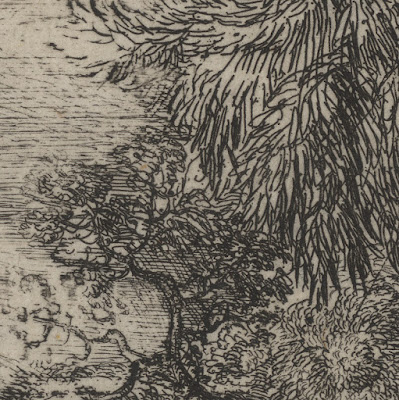Claude Lorrain (aka Claude Gellée; Claude Le Lorrain; Claudio di Lorena)
(1600–1682)
“The Flight into Egypt” (aka “Vlucht
naar Egypte”; “La fuite en Egypte”), 1630–33, printed from the original plate by McCreery in his 1816 edition of “200 Etchings”.
Etching on wove paper trimmed slightly
within the plate mark and backed with a support sheet.
Size: (sheet) 10.3 x 17 cm.
Inscribed on plate at lower right: “CLAU”.
State iv (of iv)
Blum 1923 2; Mannocci 1988 9; Robert-Dumesnil
1835-71 XI.1; IFF 2
The British Museum offers the following
description of this print:
“The Flight into Egypt; in a landscape,
Virgin and Child on a donkey, led by two angels and followed by Joseph”
See also the description offered by the
Rijksmuseum:
Condition: although this is a late
impression (1816), the lines are richly inked, crisp and well printed. The
sheet is in very good condition for its age (i.e. there are no tears, holes,
folds, abrasions, significant stains—but there is a small spot on the left
side—foxing or signs of use), trimmed slightly within the plate marks (as
published by McCreedy) and backed with an archival support sheet of millennium
quality washi paper.
I am selling this exceptionally rare
etching executed by the one of the most famous of the early landscape artists,
for the total cost of AU$333 (currently US$234.90/EUR209.42/GBP180.59 at the
time of this listing) including postage and handling to anywhere in the world
(but not, of course, any import duties/taxes imposed by some countries).
If you are interested in purchasing this
original etching by one of the major old masters, please contact me
(oz_jim@printsandprinciples.com) and I will send you a PayPal invoice to make
the payment easy.
This print has been sold
Tonight I’m a tad distracted from giving the details about this richly worked print that I’m posting, as there are a few
aspects to it that fascinate me. Let me begin …
This is one of Lorrain’s earlier prints
and it has the “right” mixture of a novice artist finding his way in terms of
stylistic consistency and a struggle with communicating what the print
should/could be about as suggested by the title: a biblical illustration
focused on portraying the escape of the Holy Family (aided by angels) from King
Herod’s edict to have all newly born male children killed.
Regarding my proposal that Lorrain was
struggling to find a singular expressive voice in terms of style, I see the
mimetic treatment of the treetops in the upper right as rendered with a
different mindset to the horizontal strokes rendering the sky and the cleaved
rocks in the right foreground. Note also how Lorrain changes his approach from
the rather cool formulaic treatment of these rocks to a more sensuous
cross-hatched treatment of surface contours of the broken ground shown on the
left. Interestingly, even Lorrain’s treatment of the sky reveals changes of
stylistic thinking as may be seen in the flurry of burnished adjustments
towards the middle of the sky area.
Regarding what I see
as a struggle with communicating the biblical story, to my eyes the Holy Family
is shown as somewhat “lost” in shadows rather than being given pictorial
prominence. This may be a shortfall, but from a personal
standpoint, this subordination of the Holy Family allows my eye to read the
composition as a cohesive whole—a landscape sparkling with light.










No comments:
Post a Comment
Please let me know your thoughts, advice about inaccuracies (including typos) and additional information that you would like to add to any post.